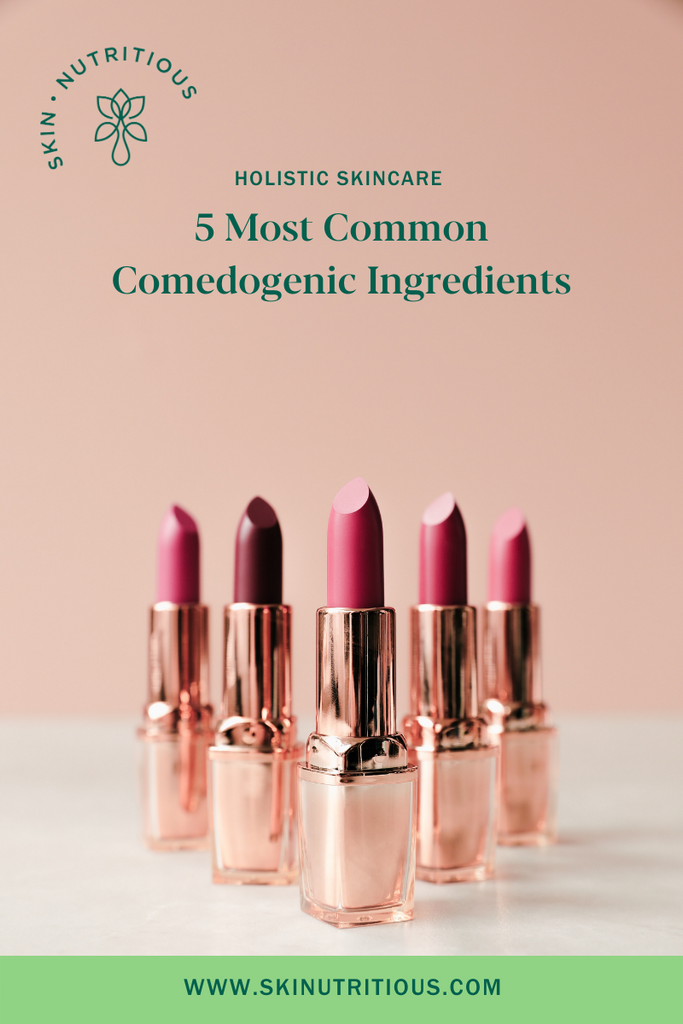5 Most Common Comedogenic Ingredients

As much as I love the trend towards natural skincare + makeup these days (I'm a super natural gal myself), a lot of that stuff is causing breakouts. In fact, I recently went to a renowned natural-only beauty store and all of the foundations I looked at had comedogenic, acne-causing ingredients (I know, I'm super sad about it too!).
No product category or company (natural or non-natural) is automatically safe from comedogenic (pore-clogging) ingredients. It is super important that if you suffer from acne, you begin to check every product you put on your skin and avoid these ingredients.
Coconut oil. Ah yes, every natural blogger on the internet is praising the skin-loving benefits of coconut oil. But alas, this ingredient has been scientifically and clinically shown to be highly pore-clogging for acneic skin. Coconut oil is most benefit for someone with extremely dry skin and zero risk of acne, or for use on body eczema or hives.
Beeswax. Commonly found in makeup foundations and concealers, beeswax is a non-breathable ingredient that quickly cuts off oxygen supply to the pores. If your makeup is doing a little too stellar of a job covering up that super red pimple, best to double check those ingredients before your concealer creates a cul-de-sac of friends around it!
Polyglyceryl-3-diisostearate. Yeesh, every time I have seen this in a client’s cosmetics, there are literally sesame seed clogs all over their face. It’s so sad and totally avoidable by steering completely clear of this ingredient! One concealer I’ve seen a couple of times with this is Bare Minerals’ bareSkin Complete Coverage Concealer. Sounds super lovely, but it comes loaded with clogs. 😥
Isopropyl myristate. Used as a thickener/lubricant in skincare, this ingredient ranks a high 5 out of 5 on the comedogenic scale. It can be found in skincare, makeup, and most shockingly, in the creamy version of prescription topical Retin-A. If you are using Retin-A for acne, it should not be the cream, but the gel.
Most oils. There are very few acne-safe carrier oils. Most that have been tested on the skin have been shown to be comedogenic oils and a whole bunch more have yet to be tested at all. I recommend to stick only with jojoba, sunflower, safflower, castor, and squalane (not squalene). Essential oils however are generally safe and are a small portion of the whole product. If you’re not sure if an oil is a carrier or essential oil, you can google to find out.
If you would like the entire list of comedogenic ingredients or my list of acne-friendly makeups, please visit my Free Resources Page.
In love, health, and community,

 Elise May, CN + LE, is a holistic esthetician, acne nutritionist, and founder of Skin Nutritious. Since 2009, she has helped over 1,300 clients overcome acne with a unique blend of coaching, treatments, and holistic skincare.
Elise May, CN + LE, is a holistic esthetician, acne nutritionist, and founder of Skin Nutritious. Since 2009, she has helped over 1,300 clients overcome acne with a unique blend of coaching, treatments, and holistic skincare.
Work with Elise.
• In San Francisco or worldwide- book online here.
• Shop her Holistic Acne Skincare line here.
.
.
The entire contents of this website are intended as a sharing of knowledge and information from the research and experience of Elise May, Skin Nutritious, and her community. Skin Nutritious encourages you to make your own health care decisions based upon your research and in partnership with a qualified health care professional. The information on this website is not intended to replace a one-on-one relationship with a qualified health care professional and is not intended as medical advice. These statements have not been evaluated by the Food and Drug Administration. This product is not intended to diagnose, treat, cure, or prevent any disease.



